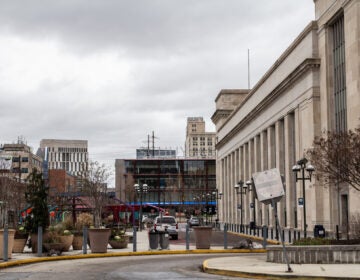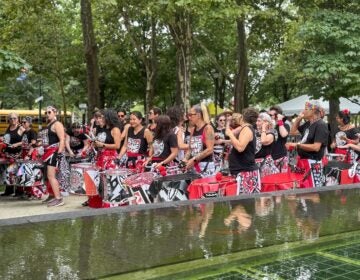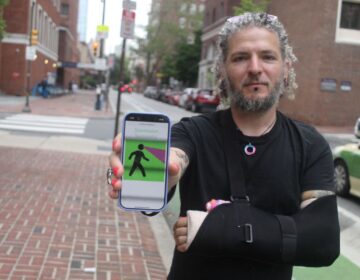Is a roundabout the answer to Henry Ave. speeding woes?
Last week, members of the East Falls Community Council were privy to the unveiling of a bold proposal that could alter the way both commuters and the local community experience a heavily-traveled intersection.
After a series of well-publicized accidents, civic leaders and advocates have what they see as a solution: a modern roundabout – known colloquially as a traffic circle – to be installed at the intersection of Henry Avenue and School House Lane in East Falls.
Leading the presentation were Meg Greenfield, 1st vice-president of the EFCC and Larry Shaeffer, founder of PhillyCarShare and a regular user of Henry Avenue. Greenfield said that this presentation was the end result of seven years of searching for traffic calming solutions, a pursuit given new urgency by a fatal accident in February.
What’s a roundabout?
Greenfield and Shaeffer noted early in their pitch that a roundabout wasn’t a retread of the so-called “Jersey circles” that are ubiquitous throughout the Garden State.
Modern roundabouts have updated design features that proponents claim reduce speed, enhance safety for both motorists and pedestrians, and could curb some of the ills endemic to the Henry Avenue corridor, which sees between 16,000 to 30,000 cars per day.
At the heart of the modern roundabout are small triangular islands that meet drivers upon entrance to the circle, which cause vehicular “deflection” relative to the center of the circle, with the net result being reduced speeds and increased efficiency through the intersection. Unlike sprawling Jersey circles, Shaeffer said a modern roundabout can be built in as little as 70 feet.
They estimated the cost of the roundabout as between $250,000 to $400,000, which one resident pointed out was not much more than Philadelphia University spends on posting a PPD officer at the intersection to oversee pedestrian crossings, said to be approximately $125,000.
Should the proposal gain traction, primary funding would likely be through PennDOT, which is in the midst of a major overhaul of the Henry Avenue corridor and already has monies allocated. Additional funds could come through city and federal grants.
In perhaps the most telling moment at the meeting – repeating a phrase found in September’s edition of The Fallser – Greenfield reported that an unnamed PennDOT engineer involved with the project said to her, “If we do that for you, everyone will want one.”
‘It’s just too early to tell’
PennDOT is currently in the preliminary stages of work along Henry Ave, a six-mile corridor that stretches from Port Royal Avenue in Andorra to Hunting Park Avenue in Allegheny West.
PennDOT spokesperson Gene Blaum said that the plan at present includes improvements and upgrades to traffic signals, along with the installation of pedestrian countdown signals at certain intersections and the addition of new stripes for left-turn lanes.
The preliminary study would commence this fall and last through the fall of 2013, with the final design and engineering phase lasting one additional year. Construction is slated to begin in 2015.
Blaum wouldn’t speculate about the roundabout, but said the preliminary engineering necessary for a roundabout is neither in the scope of the project or budget. As for the estimated $400,000 price-tag, Blaum said it seemed “extremely low” from a construction standpoint.
“It would certainly exceed $400,000, and that’s not even considering potential property impacts,” he said.
Asked to respond to Greenfield’s unattributed quote, Blaum said he checked with engineers attached to the project, none of whom acknowledged saying the quote. Asked about its perceived meaning, he replied, “I have no idea,” but affirmed PennDOT’s commitment to working with the EFCC traffic committee.
“The community has requested this, so we’ll take a look,” said Blaum. “It’s just too early to tell.”
Philadelphia University spokeswoman Debbie Goldberg was not able to provide a response before deadline.
Safety, capacity and cost
Scott Richie, roundabout specialist with Arizona-based Roundabout and Traffic Engineering, said there are three issues to consider when addressing a roundabout proposal: safety, capacity, and cost.
“Roundabouts have a stellar statistical safety record,” he said, noting 80-percent average reductions in injuries, 90-percent reductions in fatalities, and 30-percent reductions in pedestrian accidents.
Capacity is determined by matching traffic volumes with proper design, which in the case of Henry Ave. would likely result in a multi-lane roundabout.
As for cost, Richie said pricing varies greatly between projects, observing that he has completed roundabout projects from $40,000 all the way to “millions.” Maintenance costs are also less than at a signaled intersection.
“Even roundabouts that operate less effectively still see more safety and more capacity for roundabout users,” he surmised.
Asked about the performance in the midst of a college campus, Richie observed that while there are negative perceptions about pedestrian safety, “they work really well for high amounts of pedestrians.”
This isn’t the only perception that plagues roundabouts: many Americans find them unsettling.
“They’re still different, and they’re still new,” he said. “Change is a difficult thing to accept.”
Nearby experience with traffic circles
Standing at the intersection of Henry Avenue and School House Lane, one need not look farther than nearby Blue Bell Hill for an older type of roundabout. At the intersection of Walnut Lane, Johnson Street and W. Cliveden Street, lies what neighbors refer to simply as “the circle.”
Ron Goldwyn is president of the Blue Bell Hill Civic Association. He said the circle works well at calming traffic, especially after a recent rerouting of traffic entering the circle, whereby motorists entering the circle must now yield.
“There’s a lot of speeding on Walnut Lane, but the circle helps slow them down,” said Goldwyn, allowing that drivers often pick up their speed upon exiting the circle.
Asked for his response to the EFCC presentation, Goldwyn said he wasn’t sure about arguments from a traffic standpoint, but shared that his circle is a “great introduction to the neighborhood.”
A proposal in its early stages
EFCC leaders emphasized that the roundabout is a proposal – not policy.
Tom Sauerman, president of the EFCC, said that the roundabout scheme was only a “presentation,” and had not yet reached the EFCC’s Traffic Committee, approval from which would precede a formal vote from the larger membership of the EFCC.
Since the meeting, Greenfield said she’s heard “not a word” in feedback from residents, but relayed that she will continue to move forward with her roundabout plans.
However, the office of Councilman Curtis Jones, Jr. said there is “good news” in store.
“We are happy to announce PennDOT will have a detailed plan and proposal for the upcoming construction in 2014 for the entire Henry Avenue covering the communities of East Falls, Roxborough, Wissahickon and Upper Roxborough and available to present throughout November,” they said in a statement.
No further details were provided.
Reaction from pedestrians
While residents spoke both strongly for and strongly against the presentation at last week’s meeting, the response at the intersection was mostly skeptical.
Kevin Williams, a freshman at Philadelphia University, said a roundabout would further confuse traffic.
“It’s hard enough to turn as it is,” he continued, adding that resultant confusion could cause additional accidents.Woody Marcus, a Germantown resident, agreed with Williams’ observation, and added that it could lead to students hanging out in the circle.
“They should leave it as it is,” he said. “It’s barely making an ‘A’ as it is.”
As Marcus finished his sentence, a Gold Toyota Camry screeched to a stop only before him, almost rear-ending the car in front of it.
“Like that,” he said, pointing at the car. “He wasn’t even on his phone.”
Editor’s note: The word “roundabout” in the section pertaining to the Walnut Lane circle was never intended to indicate a modern roundabout. It is not a modern roundabout; it’s an older version a roundabout and the copy now clarifies that point.
NewsWorks spent 10 hours on Lincoln Drive, Kelly Drive and Henry Avenue in Northwest Philadelphia last week logging traffic speeds with a radar gun. Check back for a full report next week on how many of the 700 cars logged were driving over the speed limit.
WHYY is your source for fact-based, in-depth journalism and information. As a nonprofit organization, we rely on financial support from readers like you. Please give today.




